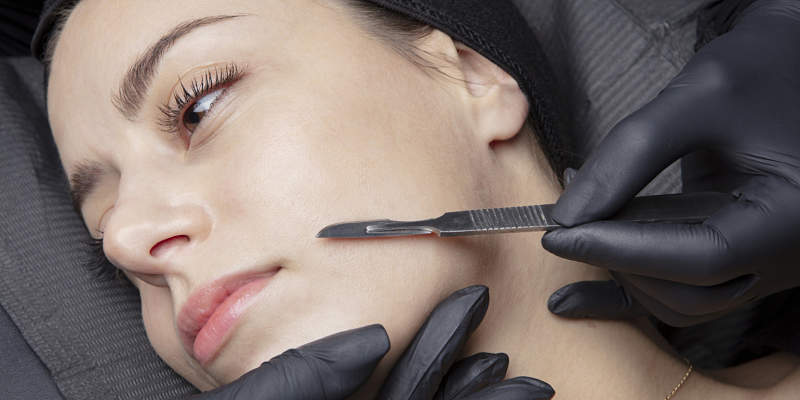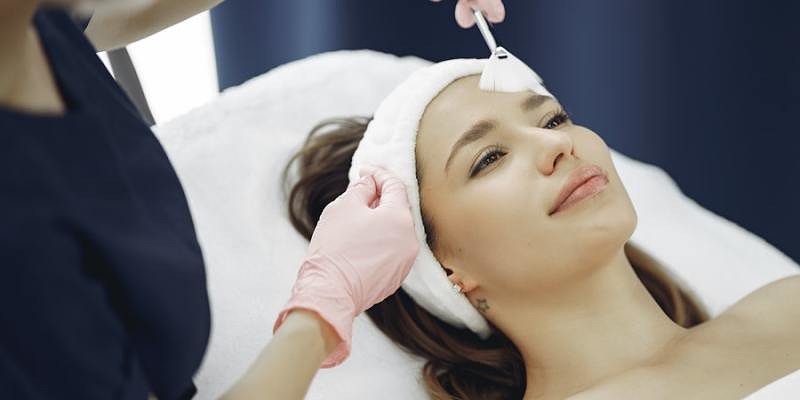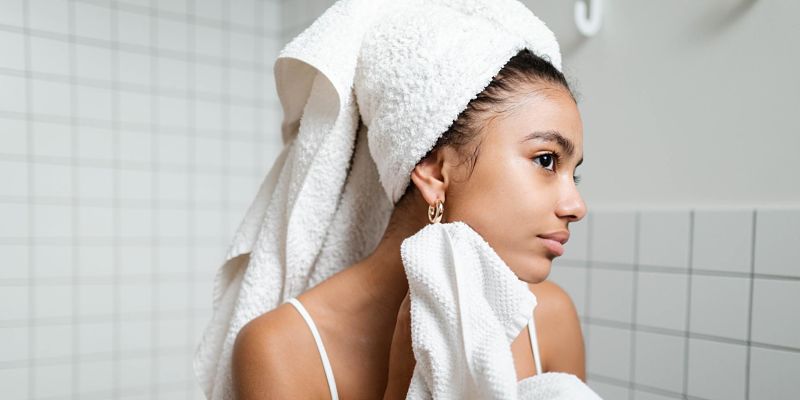Dermaplaning Vs Chemical Peels
Dermaplaning and chemical peels are both types of facial treatments used to regenerate the skin. Both are forms of exfoliation. Dermaplaning is a physical exfoliator, whereas chemical peels are chemical exfoliators. The former has become extremely popular and is a treatment that offers fast and quick results, however, it can be extremely damaging for the skin in the long-term.
Dermaplaning relies on an exfoliating blade to remove the top layer of dead skin cells and hair. However, it may come as no surprise that dermaplaning often results in cuts, as well as the stripping of the skin barrier.
In comparison, chemical peels are much safer as they aren't as abrasive. Furthermore, there's a risk of infection with dermaplaning, while there's minimal to no risk with chemical peels. Chemical peels also treat a wide range of conditions, including acne, as well as providing anti-aging effects.
What Is Dermaplaning?
Dermaplaning is a skincare treatment that uses an exfoliating blade to remove the top layer of dead skin cells and hair on the surface of the skin. It aims to improve:
- peach fuzz (the small hairs on your face)
- deep acne scarring
- the appearance of wrinkles to give skin a radiant surface
At a 45 degree angle, a sterile razor gently scrapes across the face to remove the top layer of skin debris. During the day harsh environmental aggressors damage the skin often leading to the top layer of the skin looking dull and discoloured. Dermaplaning aims to remove that top layer of skin debris to expose a brighter, newer layer of skin cells. As well as this, it also removes peach fuzz.
For those who wear make-up often, peach fuzz can be a nightmare. The pesky hairs worsen the appearance of foundation and other liquid or cream products. The thought is that by removing peach fuzz the skin’s surface is smoother, making for better make-up application. Additionally, there's some speculation that peach fuzz can be an area for the build-up of bacteria during the day. This possesses the potential to lead to acne. The dermaplaning treatment typically takes place in a clinic, however there's been a surge in popularity of at-home dermaplaning kits.
What Are the Disadvantages of Dermaplaning?
Dermaplaning is essentially a method of exfoliation. Exfoliation is important for the skin, especially if you suffer from acne. It helps to increase cell renewal by removing the top layer of dead skin cells (a common site for bacteria). These bacteria can cause acne and clogged pores.
There are two methods of exfoliation: physical and chemical. Dermaplaning falls under physical exfoliation which can be a lot more harmful to the skin than chemical. Some reasons for this are:
1. Abrasiveness
As the method is very physical, removing the top layer of skin cells in this way strips the skin of its protective barrier. Over time this leads to inflammation, irritation and dryness. If you already have severe acne or sensitive skin the damage could be irreversible.
Stripping the skin of its natural barrier also makes it more susceptible to damaging free radicals, and UV rays. This is one of the leading causes of premature aging skin.
2. Risk of Infection
During lockdown, many turned to at-home dermaplaning kits. Apps like TikTok contributed to a boom in dermaplaning's popularity. However, with many users not properly researching the treatment and using non-sterile tools, the risk factor of infection soars. Any infection makes any pre-existing conditions such as acne a lot worse.
3. Short-Term
Dermaplaning offers instant results. However, the top layer of skin soon becomes dull and discoloured again, requiring further treatment once again. What's more, the whole cycle of benefits is very short. Dermaplaning doesn’t offer any long-term solution for acne, or the skin in general.
Does Dermaplaning Help Wrinkles?
For those who already have visible wrinkles, dermaplaning may be able to provide an improvement in appearance. This is because a newer layer of skin cells become visible. This means the skin may appear smoother and less discoloured. However, this effect is only temporary.
In the long-term dermaplaning can't offer effective exfoliation. Therefore, the treatment is unable to stimulate a speedier cell regeneration process, meaning it’s not helping wrinkles in the long run.
The use of serums containing retinol, vitamin C and A is a much better way to target wrinkles and ensure that they don’t develop in the long term. We recommend the Retinol Skin Booster from MZ Skin, or the Retinol Treatment For Sensitive Skin from PCA Skin.
For someone who's younger and whose skin is still more elastic, dermaplaning can cause even more damage. Side effects include drying out and causing the skin to become sensitive. As well as this it also causes damage to the skin's collagen.
The best way to prevent wrinkles is to regularly chemically exfoliate, for example by having a gentle chemical peel. As well as this, wear SPF daily.
What’s the Difference Between a Peel and Dermaplaning?
Both dermaplaning and chemical peels are forms of exfoliation. Both work to exfoliate the top layer of your skin, however they do this in different ways.
Peels are chemical exfoliants, while dermaplaning is physical. This is because dermaplaning relies on tools and physical friction to remove dead skin cells, while peels rely solely on their active ingredients.
Physical exfoliation is the most common at-home exfoliation type. Examples other than dermaplaning are granular face scrubs, and loofers.
Another difference between physical and chemical exfoliants is that chemical exfoliants, such as peels have the ability to penetrate deeper. This allows for more effective and longer lasting effects.
Why Chemical Peels Are Safer Than Dermaplaning
Chemical peels are a chemical way of exfoliating the face. There are 3 types of chemical peels relating to their strength; these are light, medium and deep. They work by using acids to break down the top layer of the skin. Although the mention of acids and chemicals can be daunting, peels are gentle on the skin when carried out correctly. However, this obviously depends on the strength of the peel too. Chemical peels aim to improve acne, improve the appearance of hyperpigmentation, wrinkles and even some scarring. Furthermore, they're a great anti-aging treatment in general.
The biggest benefit of chemical peels is that they're much safer in terms of longer lasting skin health. In comparison to dermaplaning, they aren’t as abrasive. This is because they don’t physically remove the dead skin cells. Instead, they chemically dissolve skin cells. This means there's less sensitivity, risk of inflammation and irritation. However, some may experience sensitivity to some ingredients contained within the peel. Also unlike dermaplaning, there's minimal to no risk of infection with chemical peels. This is because chemical peels require no equipment, such as razors. What’s more, is that they go far beyond the work of dermaplaning.
Chemical peels penetrate the skin meaning that they can effectively prevent new acne from forming, while also killing any bacteria on the skin’s surface. Therefore, in the long-term, chemical peels are much more effective and safer.
Should You Dermaplane Before a Chemical Peel?
There's a lot of debate about whether you can dermaplane before a chemical peel in the skincare community.
As dermaplaning is seen quite positively in the media right now, a big statement is that it can even enhance the effects of a chemical peel. The explanation is that as it removes the top barrier of dead skin cells, this makes for an easier surface for the chemical peel to penetrate and be absorbed into the skin. However, the combination of the 2 treatments is far too aggressive. Furthermore, if you’re someone with sensitive skin this is way too much for the skin to handle.
As dermaplaning is an abrasive treatment, the skin needs recovery time afterwards. This is to regenerate new skin cells and build up the skin barrier. A chemical peel, whilst safer than dermaplaning, is still exfoliation and will sensitise the skin. Overall these two treatments in combination are just too much exfoliation! It could leave the skin red, inflamed and sensitised. The inflammation could even lead to acne. On top of this, the new level of sensitivity may cause your skin to react to other products which are already in your skincare routine, or even make-up.
Which Chemical Peels Are Best for Aging Skin?
Chemical peels always require application by a trained dermatologist or aesthetician. When handling pharmaceutical-grade ingredients it's much better to be in the hands of someone more educated. As well as this being safer, a trained professional is also able to adapt the treatment specifically to you and your skin needs.
We recommend the PCA Skin Bespoke Signature Peel. This high-performance facial peel provides an instant glow, lift, and strength to your skin. The advanced facial peel incorporates enzymatic, chemical, and retinoid based exfoliation. This allows for optimal results. It also provides a completely customisable exfoliation to suit all skin types and conditions. The PCA Skin chemical peel corrects skin damage, stimulates skin repair, and boosts collagen production.
As well as this, the PCA peel uses galvanic technology, ultrasound stimulation, vibrational massage and blue, red, and/or green LED light therapy. Together these treatments work to smooth out facial wrinkles. As well as this they also tighten the facial muscles. It also boosts blood circulation, and stimulates new skin cell production.
If you're based in London, one of our trained aestheticians can deliver this treatment from the comfort of your home.
PCA Skin Chemical Peel Key Benefits
- Softens, plumps, and firms the skin
- Provides a 10hr release of actives
- Effective against all skin discolouration and texture
- Extremely effective in targeting and eliminating fine line and wrinkles
- Provides intense skin rejuvenation and cell renewal
How Many Days After Chemical Peels Should You Start to See Peeling?
Peeling typically begins about 2-3 days after receiving a chemical peel. Furthermore, it can last up to 5 days in total after the treatment. However, it is important to not peel your skin after this treatment. Instead, simply control it with moisturiser as peeling is minimal and manageable. Peeling too early after the treatment can result in dry and irritated skin. This can lead to hyperpigmentation so is to be avoided!
How Often Should You Get Chemical Peels?
This is all dependent on which type of chemical peel you receive. As mentioned, there are three types of chemical peel ordered by strength: light, medium and deep.
Light chemical peels are the most common. They can be done every 2-5 weeks depending on how sensitive your skin is, or how many chemical peels you’ve done before. This number comes from your skin’s regeneration cycle. The skin cycle lasts about 3-4 weeks. This means that after a month you have a new layer of skin cells in the epidermis. So by this time, the effects of your chemical peel have worn off and it’s time to get the procedure again.
Medium chemical peels penetrate much deeper into the skin and typically don’t need to be repeated regularly. After the first chemical peel, it can next be repeated after 2-9 months. However, this all depends on how well your skin recovers and adapts.
Deep chemical peels should only ever be done once as the effects are long-lasting. Medium and deep chemical peels are typically only carried out by dermatologists. Light chemical peels on the other hand are very common and the treatments are administered by aestheticians.
How Long Do Chemical Peel Results Last?
Firstly, this all depends on what type of chemical peel you get. As previously mentioned, the skin cycle is 3-4 weeks. Therefore, for light chemical peels the results will start to fade after this marked point. However, that’s also determined by your skin condition. Factors which contribute to this include whether you have a consistent skincare routine, if you wear SPF etc.
Medium chemical peels are much stronger. Just one treatment can provide more lasting benefits. However, after about 6 months results begin to fade.
Deep chemical peels are a complex procedure and can only be carried out by doctors. However, that being said deep chemical peels will last for years. This is due to how far they penetrate into the skin.
At What Age Should You Start Getting Chemical Peels?
Chemical peels can treat a range of skincare concerns from signs of aging, to severe acne. However, chemical peels should only be administered following puberty. Now that looks different for everyone. For most puberty hits in your late teens, but it's not uncommon for this to stretch to your early twenties. However, if you’re looking to prolong elasticity and fight signs of aging, the ideal time to start chemicals peels is in your mid twenties. This is to prevent the development of wrinkles, rather than starting treatments once you’ve already reached that point as otherwise it can be much harder.
Overall, there are a vast number of skincare treatments out there for you to explore and decide what’s best for you. However, always do your research as many popular trends can be extremely harmful to the skin. For more information on which treatments to avoid, check out our in-depth article here.
Additionally, it’s important to make sure that you always do skincare treatments with a licensed professional rather than an attempt at home yourself.






